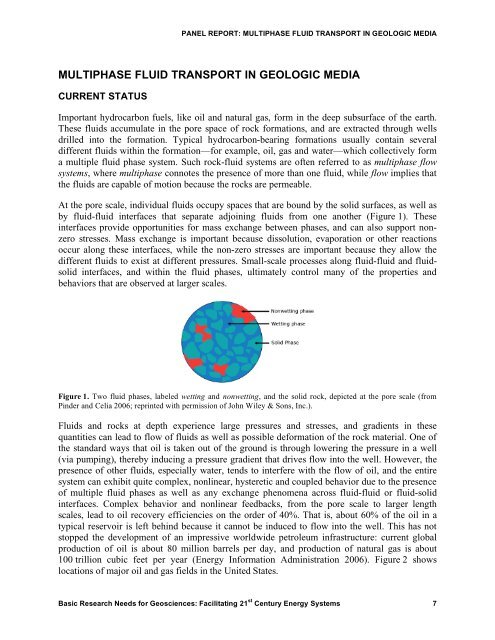Basic Research Needs for Geosciences - Energetics Meetings and ...
Basic Research Needs for Geosciences - Energetics Meetings and ...
Basic Research Needs for Geosciences - Energetics Meetings and ...
- No tags were found...
You also want an ePaper? Increase the reach of your titles
YUMPU automatically turns print PDFs into web optimized ePapers that Google loves.
PANEL REPORT: MULTIPHASE FLUID TRANSPORT IN GEOLOGIC MEDIAMULTIPHASE FLUID TRANSPORT IN GEOLOGIC MEDIACURRENT STATUSImportant hydrocarbon fuels, like oil <strong>and</strong> natural gas, <strong>for</strong>m in the deep subsurface of the earth.These fluids accumulate in the pore space of rock <strong>for</strong>mations, <strong>and</strong> are extracted through wellsdrilled into the <strong>for</strong>mation. Typical hydrocarbon-bearing <strong>for</strong>mations usually contain severaldifferent fluids within the <strong>for</strong>mation—<strong>for</strong> example, oil, gas <strong>and</strong> water—which collectively <strong>for</strong>ma multiple fluid phase system. Such rock-fluid systems are often referred to as multiphase flowsystems, where multiphase connotes the presence of more than one fluid, while flow implies thatthe fluids are capable of motion because the rocks are permeable.At the pore scale, individual fluids occupy spaces that are bound by the solid surfaces, as well asby fluid-fluid interfaces that separate adjoining fluids from one another (Figure 1). Theseinterfaces provide opportunities <strong>for</strong> mass exchange between phases, <strong>and</strong> can also support nonzerostresses. Mass exchange is important because dissolution, evaporation or other reactionsoccur along these interfaces, while the non-zero stresses are important because they allow thedifferent fluids to exist at different pressures. Small-scale processes along fluid-fluid <strong>and</strong> fluidsolidinterfaces, <strong>and</strong> within the fluid phases, ultimately control many of the properties <strong>and</strong>behaviors that are observed at larger scales.Figure 1. Two fluid phases, labeled wetting <strong>and</strong> nonwetting, <strong>and</strong> the solid rock, depicted at the pore scale (fromPinder <strong>and</strong> Celia 2006; reprinted with permission of John Wiley & Sons, Inc.).Fluids <strong>and</strong> rocks at depth experience large pressures <strong>and</strong> stresses, <strong>and</strong> gradients in thesequantities can lead to flow of fluids as well as possible de<strong>for</strong>mation of the rock material. One ofthe st<strong>and</strong>ard ways that oil is taken out of the ground is through lowering the pressure in a well(via pumping), thereby inducing a pressure gradient that drives flow into the well. However, thepresence of other fluids, especially water, tends to interfere with the flow of oil, <strong>and</strong> the entiresystem can exhibit quite complex, nonlinear, hysteretic <strong>and</strong> coupled behavior due to the presenceof multiple fluid phases as well as any exchange phenomena across fluid-fluid or fluid-solidinterfaces. Complex behavior <strong>and</strong> nonlinear feedbacks, from the pore scale to larger lengthscales, lead to oil recovery efficiencies on the order of 40%. That is, about 60% of the oil in atypical reservoir is left behind because it cannot be induced to flow into the well. This has notstopped the development of an impressive worldwide petroleum infrastructure: current globalproduction of oil is about 80 million barrels per day, <strong>and</strong> production of natural gas is about100 trillion cubic feet per year (Energy In<strong>for</strong>mation Administration 2006). Figure 2 showslocations of major oil <strong>and</strong> gas fields in the United States.<strong>Basic</strong> <strong>Research</strong> <strong>Needs</strong> <strong>for</strong> <strong>Geosciences</strong>: Facilitating 21 st Century Energy Systems 7
















